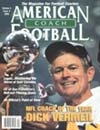Article CategoriesAFM Magazine
|
The Calm After The StormSteve Logan has weathered the elements at East Carolina—both of the natural variety and otherwise. But when the \'99 season was over, he had his Pirates on top of the Tar Heel State.by: Kevin Kaminski © More from this issue It was the cruelest possible irony. Less than two weeks after the worst natural disaster in North Carolina history had crippled 66 counties, caused what was later estimated at $6 billion in flood damage, and cost 51 people their lives, the football forecast at East Carolina called for Hurricanes. By that time, however, Steve Logan was the last person on which such madness could be lost. He was, by trade, a head coach. But in the days leading up to East Carolina's Sept. 25 date with ninth-ranked University of Miami (Fla.), Logan found himself orchestrating a survival retreat - albeit one infinitely less sobering than that facing the people in and around Greenville. Three days after Hurricane Floyd slammed the eastern portion of North Carolina, the Pirates' team bus navigated whatever open back roads it could find ....The full article can only be seen by subscribers.
|
|
|||||||
| HOME |
MAGAZINE |
SUBSCRIBE | ONLINE COLUMNISTS | COACHING VIDEOS |
Copyright 2025, AmericanFootballMonthly.com
All Rights Reserved





